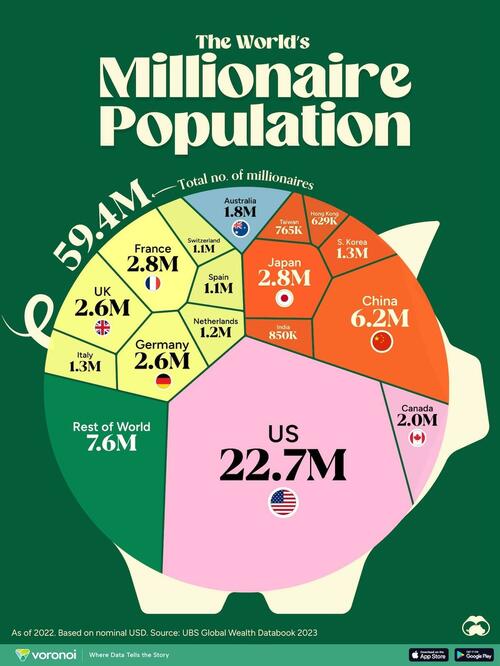
In 2022, global household wealth stood at $454 trillion, of which half was held by millionaires.
But where do the wealthiest people of the world live?
From UBS and Credit Suisse’s comprehensive Global Wealth Report 2023, Visual Capitalist's Marcus Lu visualizes the world’s millionaire population by country.
Their databook details the sources they used, including household balance sheet data from the World Bank, the World Income Inequality Database, surveys, tax data, and Forbes’ findings.
UBS defines millionaires as individuals whose total wealth (including financial and non-financial assets, minus household debt) is at or above $1 million, using “smoothed exchange rates.” These are 2021 average currency exchange rates with the U.S. dollar, adjusted for inflation differences between the U.S. and concerned country, but not adjusted for U.S. inflation between 2021 and 2022.
ℹ️ “Million” denoting just the number and not money has been shortened to ‘M’ in this article to avoid confusion when talking about millions of millionaires.
With information current up to 2022, the world has almost 60M millionaires, of which 42% reside in North America.
Note: UBS separates China and India from their Asia-Pacific region for better clarity
Within that statistic is an obvious heavyweight, and we look through the per-country millionaire population in the next section.
Ranked: Countries By Number of Millionaires
The U.S. is home to nearly 23M millionaires, 40% of the total millionaire population in the world. Six American cities feature in the world’s wealthiest cities, led by New York City, home to 340,000 millionaires.
As it happens, this quantity is actually lower than the 24M American millionaires in 2021, as average wealth in the category fell due to a decline in the value of financial assets.
The world’s second-largest economy, China, is also home to the second-highest number of wealthy individuals, at 6M, about 10% of the total millionaire population. The number of Chinese residents with more than $1 million has grown rapidly since 2012, especially in economic hotspots like Hangzhou and Shenzhen.
At third and fourth, France and Japan essentially have the same number of millionaires (2.8M) as do Germany and the UK who round out the top six with 2.6M millionaires each.
The top 10 countries with the most millionaires are the 10 largest economies in the world, with the exception of India (ranked 14th) and Brazil, which is outside the top millionaire residents ranks, but grew its millionaire population by 122,000 between 2021 and 2022.
Within this data however, UBS differentiates between the various types of millionaires.
Note: Percentages may not sum to 100 due to rounding.
Of the last category of individuals with more than $10 million, 2.5M have assets in the $10–50 million range, leaving 243,000 ultra-high-net-worth individuals with a net worth above $50 million. This ultra-high-net-worth category has grown four times since 2008.
UBS believes that by 2027, the world will have over 85M millionaires. This is 26M more than today, and 71M more from the year 2000.
In 2022, global household wealth stood at $454 trillion, of which half was held by millionaires.
But where do the wealthiest people of the world live?
From UBS and Credit Suisse’s comprehensive Global Wealth Report 2023, Visual Capitalist’s Marcus Lu visualizes the world’s millionaire population by country.
Their databook details the sources they used, including household balance sheet data from the World Bank, the World Income Inequality Database, surveys, tax data, and Forbes’ findings.
UBS defines millionaires as individuals whose total wealth (including financial and non-financial assets, minus household debt) is at or above $1 million, using “smoothed exchange rates.” These are 2021 average currency exchange rates with the U.S. dollar, adjusted for inflation differences between the U.S. and concerned country, but not adjusted for U.S. inflation between 2021 and 2022.
ℹ️ “Million” denoting just the number and not money has been shortened to ‘M’ in this article to avoid confusion when talking about millions of millionaires.
With information current up to 2022, the world has almost 60M millionaires, of which 42% reside in North America.
Note: UBS separates China and India from their Asia-Pacific region for better clarity
Within that statistic is an obvious heavyweight, and we look through the per-country millionaire population in the next section.
Ranked: Countries By Number of Millionaires
The U.S. is home to nearly 23M millionaires, 40% of the total millionaire population in the world. Six American cities feature in the world’s wealthiest cities, led by New York City, home to 340,000 millionaires.
As it happens, this quantity is actually lower than the 24M American millionaires in 2021, as average wealth in the category fell due to a decline in the value of financial assets.
The world’s second-largest economy, China, is also home to the second-highest number of wealthy individuals, at 6M, about 10% of the total millionaire population. The number of Chinese residents with more than $1 million has grown rapidly since 2012, especially in economic hotspots like Hangzhou and Shenzhen.
At third and fourth, France and Japan essentially have the same number of millionaires (2.8M) as do Germany and the UK who round out the top six with 2.6M millionaires each.
The top 10 countries with the most millionaires are the 10 largest economies in the world, with the exception of India (ranked 14th) and Brazil, which is outside the top millionaire residents ranks, but grew its millionaire population by 122,000 between 2021 and 2022.
Within this data however, UBS differentiates between the various types of millionaires.
Note: Percentages may not sum to 100 due to rounding.
Of the last category of individuals with more than $10 million, 2.5M have assets in the $10–50 million range, leaving 243,000 ultra-high-net-worth individuals with a net worth above $50 million. This ultra-high-net-worth category has grown four times since 2008.
UBS believes that by 2027, the world will have over 85M millionaires. This is 26M more than today, and 71M more from the year 2000.
Loading…








